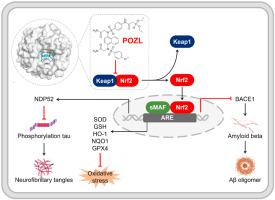Redox Biology ( IF 10.7 ) Pub Date : 2023-06-24 , DOI: 10.1016/j.redox.2023.102793 Yi Sun 1 , Lijuan Xu 2 , Dongpeng Zheng 1 , Jue Wang 1 , Guodong Liu 3 , Zixin Mo 1 , Chao Liu 1 , Wannian Zhang 2 , Jianqiang Yu 4 , Chengguo Xing 5 , Ling He 1 , Chunlin Zhuang 2

|
The Keap1-Nrf2 pathway has been established as a therapeutic target for Alzheimer's disease (AD). Directly inhibiting the protein-protein interaction (PPI) between Keap1 and Nrf2 has been reported as an effective strategy for treating AD. Our group has validated this in an AD mouse model for the first time using the inhibitor 1,4-diaminonaphthalene NXPZ-2 with high concentrations. In the present study, we reported a new phosphodiester containing diaminonaphthalene compound, POZL, designed to target the PPI interface using a structure-based design strategy to combat oxidative stress in AD pathogenesis. Our crystallographic verification confirms that POZL shows potent Keap1-Nrf2 inhibition. Remarkably, POZL showed its high in vivo anti-AD efficacy at a much lower dosage compared to NXPZ-2 in the transgenic APP/PS1 AD mouse model. POZL treatment in the transgenic mice could effectively ameliorate learning and memory dysfunction by promoting the Nrf2 nuclear translocation. As a result, the oxidative stress and AD biomarker expression such as BACE1 and hyperphosphorylation of Tau were significantly reduced, and the synaptic function was recovered. HE and Nissl staining confirmed that POZL improved brain tissue pathological changes by enhancing neuron quantity and function. Furthermore, it was confirmed that POZL could effectively reverse Aβ-caused synaptic damage by activating Nrf2 in primary cultured cortical neurons. Collectively, our findings demonstrated that the phosphodiester diaminonaphthalene Keap1-Nrf2 PPI inhibitor could be regarded as a promising preclinical candidate of AD.
中文翻译:

一种有效的磷酸二酯 Keap1-Nrf2 蛋白-蛋白相互作用抑制剂,可有效治疗阿尔茨海默病
Keap1-Nrf2 通路已被确定为阿尔茨海默病 (AD) 的治疗靶点。据报道,直接抑制 Keap1 和 Nrf2 之间的蛋白质相互作用 (PPI) 是治疗 AD 的有效策略。我们的团队首次使用高浓度抑制剂 1,4-二氨基萘 NXPZ-2 在 AD 小鼠模型中验证了这一点。在本研究中,我们报道了一种含有二氨基萘化合物的新型磷酸二酯 POZL,旨在使用基于结构的设计策略靶向 PPI 界面,以对抗 AD 发病机制中的氧化应激。我们的晶体学验证证实 POZL 显示出有效的 Keap1-Nrf2 抑制作用。值得注意的是,与 NXPZ-2 相比,POZL 在转基因 APP/PS1 AD 小鼠模型中以低得多的剂量显示出高体内抗 AD 功效。POZL治疗转基因小鼠可通过促进Nrf2核易位有效改善学习记忆功能障碍。结果,氧化应激和 AD 生物标志物表达(如 BACE1 和 Tau 过度磷酸化)显着降低,突触功能得到恢复。HE和尼氏染色证实POZL通过增强神经元数量和功能来改善脑组织病理变化。此外,还证实 POZL 可以通过激活原代培养的皮质神经元中的 Nrf2 来有效逆转 Aβ 引起的突触损伤。总的来说,我们的研究结果表明,磷酸二酯二氨基萘 Keap1-Nrf2 PPI 抑制剂可被视为一种有前途的 AD 临床前候选药物。


















































 京公网安备 11010802027423号
京公网安备 11010802027423号